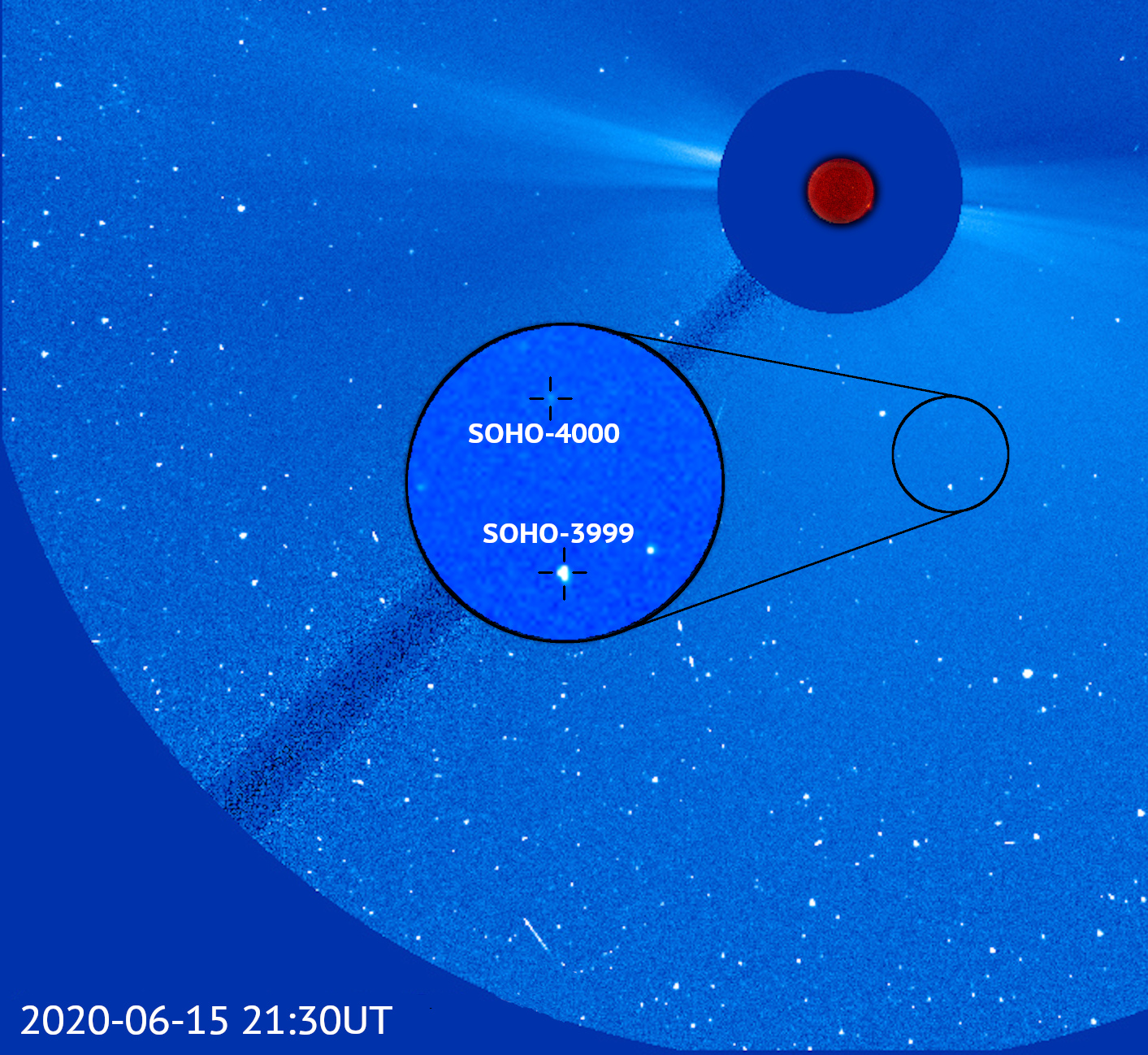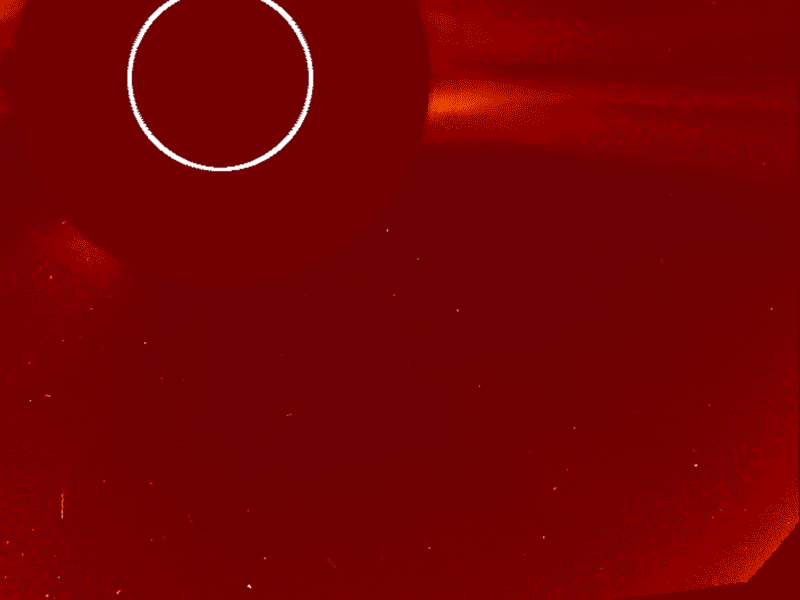On June 15, 2020, a citizen scientist spotted a never-before-seen comet in data from the Solar and Heliospheric Observatory, or SOHO — the 4,000th comet discovery in the spacecraft’s 25-year history.
The comet is nicknamed SOHO-4000, pending its official designation from the Minor Planet Center. Like most other SOHO-discovered comets, SOHO-4000 is part of the Kreutz family of sungrazers. The Kreutz family of comets all follow the same general trajectory, one that carries them skimming through the outer atmosphere of the Sun. SOHO-4000 is on the small side, with a diameter in the range of 15-30 feet, and it was extremely faint and close to the Sun when discovered — meaning SOHO is the only observatory that has spotted the comet, as it’s impossible to see from Earth with or without a telescope.

“I feel very fortunate to have found SOHO’s 4,000th comet. Although I knew that SOHO was nearing its 4,000th comet discovery, I did not initially think that this sungrazer would be it,” said Trygve Prestgard, who first spotted the comet in SOHO’s data. “It was only after discussing with other SOHO comet hunters, and counting through the most recent sungrazer discoveries, that the idea sunk in. I am honored to be part of such an amazing collaborative effort.”
SOHO is a joint mission of the European Space Agency (ESA) and NASA. Launched in 1995, SOHO studies the Sun from its interior to its outer atmosphere, with an uninterrupted view from its vantage point between the Sun and Earth, about a million miles from our planet. But over the past two and half decades, SOHO has also become the greatest comet finder in human history.
SOHO’s comet-hunting prowess comes from a combination of its long lifespan, its sensitive instruments focused on the solar corona, and the tireless work of citizen scientists who scour SOHO’s data for previously-undiscovered comets, which are clumps of frozen gases, rock and dust that orbit the Sun.
Credits: NASA’s Goddard Space Flight Center
Download this video in HD formats from NASA Goddard’s Scientific Visualization Studio.
“Not only has SOHO rewritten the history books in terms of solar physics, but, unexpectedly, it’s rewritten the books in terms of comets as well,” said Karl Battams, a space scientist at the U.S. Naval Research Lab in Washington, D.C., who works on SOHO and manages its comet-finding program.
The vast majority of comets found in SOHO’s data are from its coronagraph instrument, called LASCO, short for Large Angle and Spectrometric Coronagraph. Like other coronagraphs, LASCO uses a solid object — in this case, a metal disk — to block out the Sun’s bright face, allowing its cameras to focus on the relatively faint outer atmosphere, the corona. The corona is critical to understanding how the Sun’s changes propagate out into the solar system, making LASCO a key part of SOHO’s scientific quest to understand the Sun and its influence.
But focusing on this faint region also means LASCO can do something other telescopes can’t — it can see comets flying extremely close to the Sun, called sungrazers, which are otherwise blotted out by the Sun’s intense light and impossible to see. This is why nearly all of SOHO’s 4,000 comet discoveries have come from LASCO’s data.
Like most who have discovered comets in SOHO’s data, Prestgard is a citizen scientist, searching for comets in his free time with the Sungrazer Project. The Sungrazer Project is a NASA-funded citizen science project, managed by Battams, which grew out of comet discoveries by citizen scientists early into SOHO’s mission.
“I have been actively involved in the Sungrazer Project for about eight years. My work with sungrazers is what solidified my long-term interest in planetary science,” said Prestgard, who recently completed a master’s degree in geophysics from Université Grenoble Alpes in France. “I enjoy the feeling of discovering something previously unknown, whether this is a nice “real time” comet or a “long-gone” overlooked one in the archives.”
In total, Prestgard has discovered around 120 previously-unknown comets using data from SOHO and NASA’s STEREO mission.
Copious comets
This 4,000th comet discovery came earlier than scientists initially expected — a byproduct of SOHO’s teamwork with the Parker Solar Probe mission. In coordination with Parker Solar Probe’s fifth flyby of the Sun, the SOHO team ran a special observation campaign in early June, increasing the frequency with which the LASCO instrument takes images of the Sun’s corona, as well as doubling the exposure time for each image. These changes in LASCO’s imaging were designed to help the instrument pick up faint structures that would later pass over Parker Solar Probe.
“Since Parker Solar Probe was crossing the plane of the sky as seen from Earth, the structures that we see from SOHO’s coronagraphs will be in the path of Parker Solar Probe,” said Angelos Vourlidas, an astrophysicist at the Johns Hopkins University Applied Physics Lab, in Laurel, Maryland, who works on the Parker Solar Probe and SOHO missions. “It’s the optimal configuration to do this type of imaging.”
These more-sensitive images also revealed a number of comets that, based on their brightness, would have been too faint to see in SOHO’s regular, shorter-exposure images. SOHO typically sees an uptick in comet discoveries each June, because Earth’s position in space places SOHO at a good angle to see sunlight reflecting off of comets following the Kreutz path, a family of comets that accounts for about 85% of the comets discovered by SOHO. But this June saw 17 comets discovered in the first nine days of the month, around double the normal rate of discoveries.
“Our exposure time is twice as long, so we’re gathering way more light, and seeing comets that are otherwise too faint for us to see — it’s just like any long-exposure photography,” said Battams. “It’s possible that if we doubled exposure time again, we’d see even more comets.”
SOHO is a cooperative effort between ESA and NASA. Mission control is based at NASA’s Goddard Space Flight Center in Greenbelt, Maryland. SOHO’s Large Angle and Spectrometric Coronagraph Experiment, or LASCO, which is the instrument that provides most of the comet imagery, was built by an international consortium, led by the U.S. Naval Research Lab.
Related:
By Sarah Frazier
NASA’s Goddard Space Flight Center, Greenbelt, Md.



























